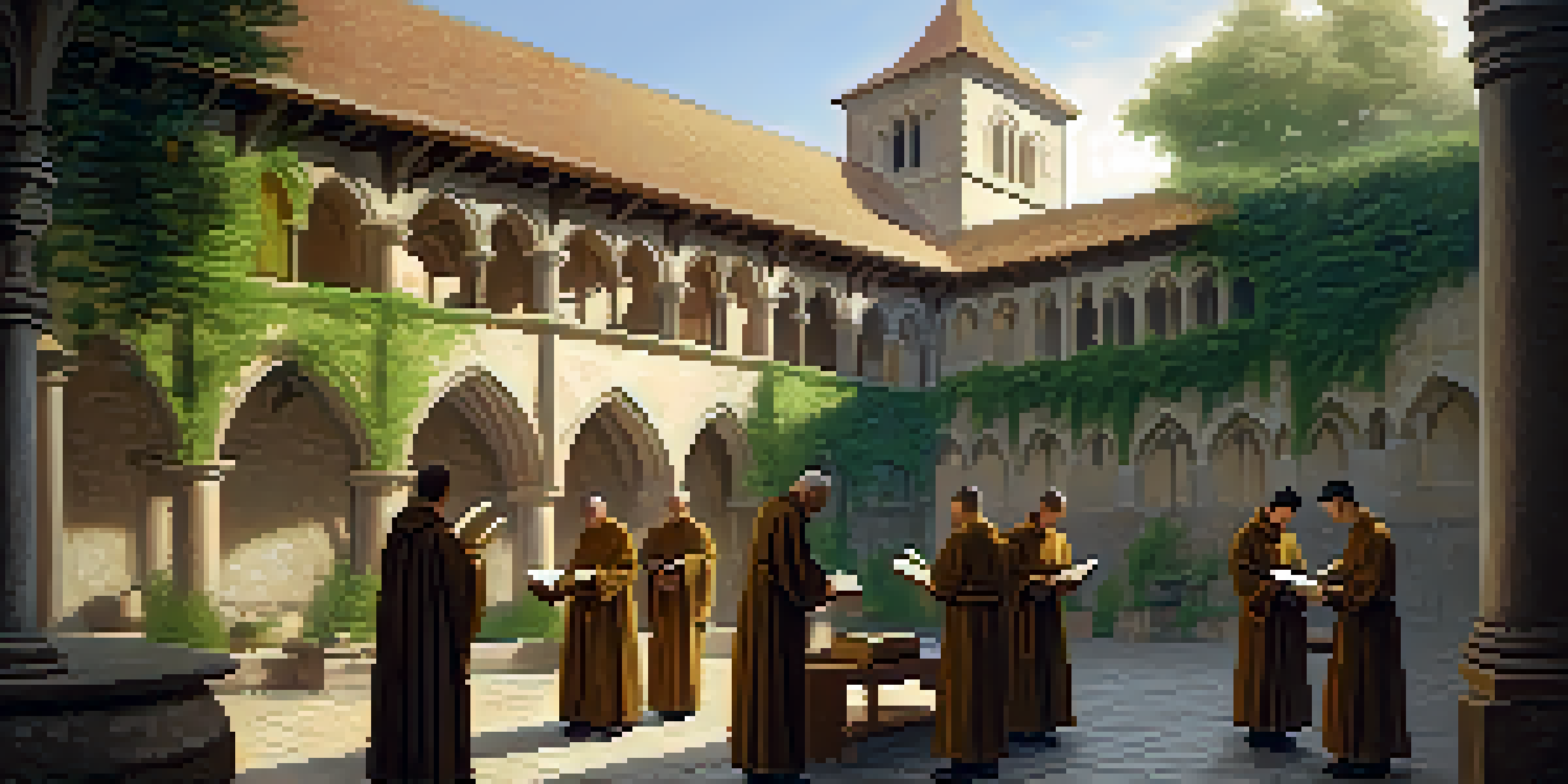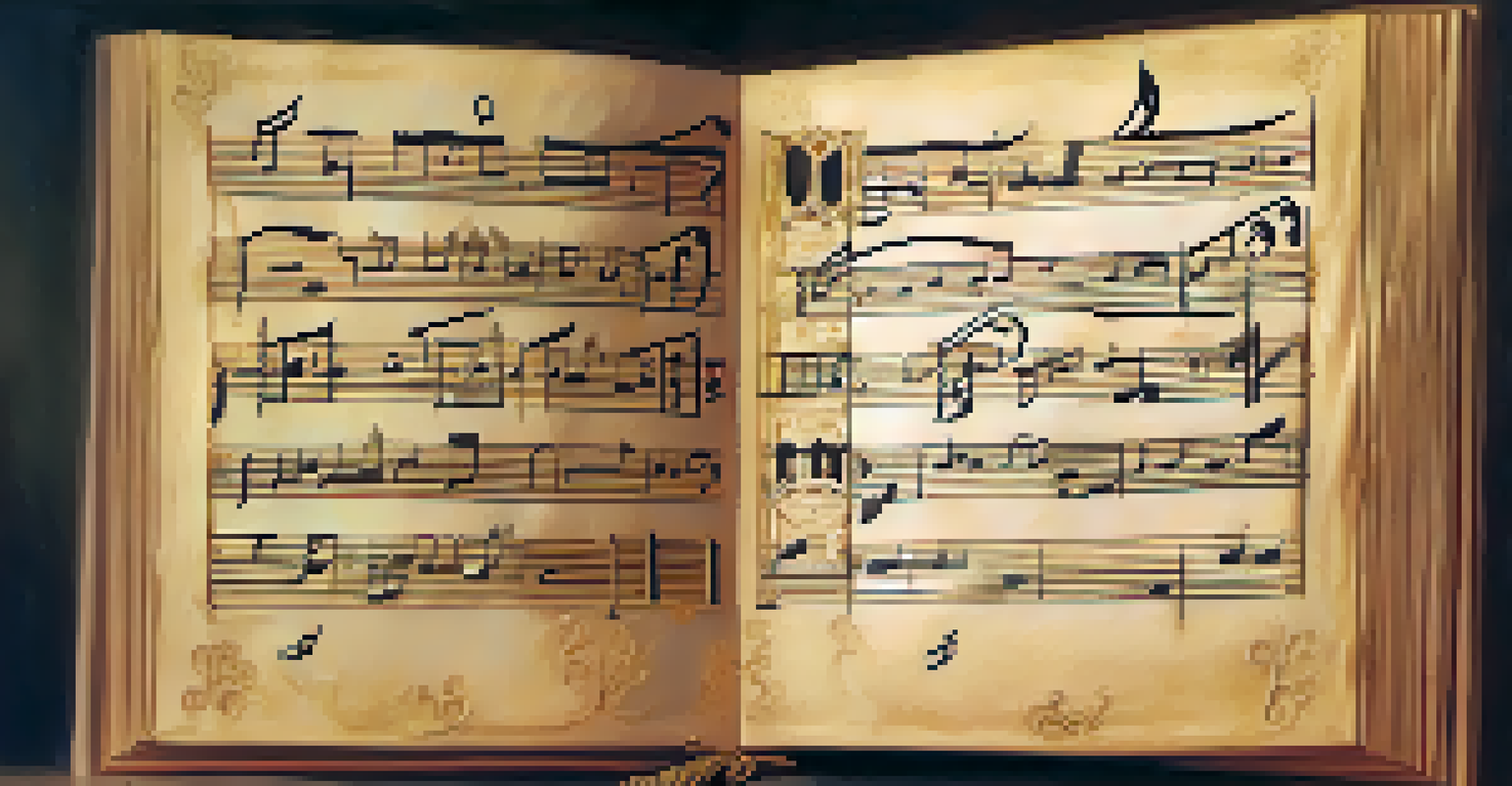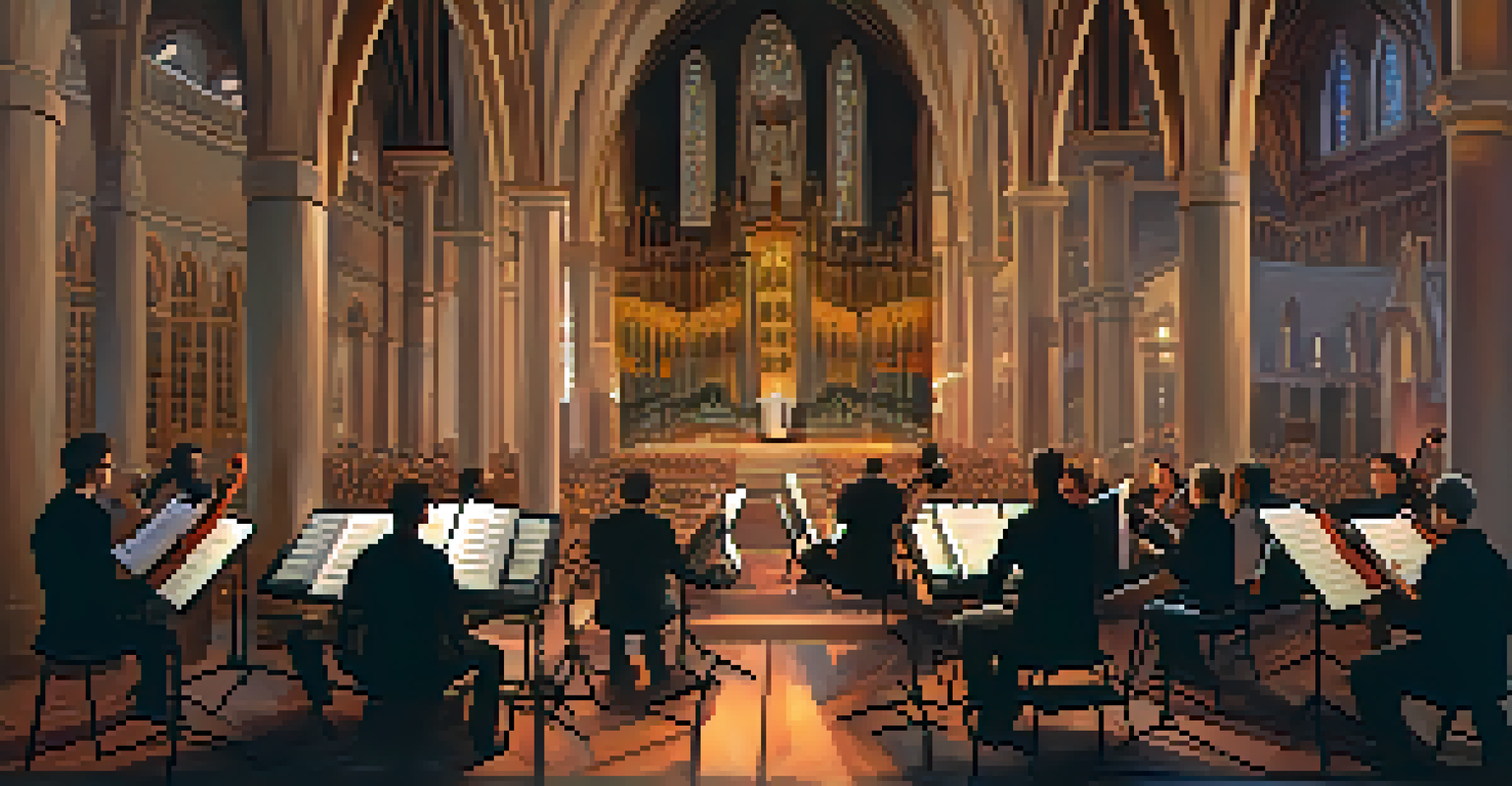Gregorian Chant: Spirituality and Musical Form in the Middle Ages

The Origins of Gregorian Chant in the Early Church
Gregorian Chant has its roots in the early Christian church, where music was an integral part of worship. Initially, chants were simple, monophonic melodies sung in Latin, designed to enhance the spiritual experience. The name 'Gregorian' is attributed to Pope Gregory I, who played a pivotal role in organizing these chants around the 6th century.
Music is the shorthand of emotion.
The chants served not just as music, but as a way to convey theological messages and foster community among worshippers. This practice emphasized the importance of music in expressing devotion and connecting with the divine. Over time, these chants evolved, incorporating various regional styles and influences.
As the church grew in influence, so did the complexity and reach of Gregorian Chant, laying a foundation for Western music. The simplicity of the melodies allowed for easy memorization, making it accessible to many. Thus, Gregorian Chant became a cornerstone of liturgical music, deeply entwined with the spirituality of the Middle Ages.
The Structure and Characteristics of Gregorian Chant
Gregorian Chant is characterized by its unique structure, consisting of a single melodic line without harmonic accompaniment. This monophonic nature creates an ethereal quality, allowing the text's spiritual message to shine through. The chants typically follow a free-flowing rhythm, following the natural cadence of the Latin language.

One of the key features of Gregorian Chant is the use of modes, which are scales that provide a distinct emotional character to the music. Each mode evokes different feelings, influencing the way worshippers experience the chant. Additionally, the melodies often rise and fall, creating a sense of movement that mirrors the spiritual journey of the listener.
Roots in Early Christian Worship
Gregorian Chant originated in the early Christian church, serving as a vital part of worship that enhanced spiritual experiences.
The text of the chants primarily derives from the Bible and liturgical prayers, reinforcing their spiritual purpose. Each phrase is carefully crafted to enhance the meaning of the words, creating a powerful connection between the music and the message. This thoughtful interplay is what makes Gregorian Chant a profound experience for both performers and congregants.
The Role of Gregorian Chant in Medieval Spirituality
In the Middle Ages, Gregorian Chant played a crucial role in shaping the spirituality of the Christian community. It was not merely a form of music but a means of expressing faith and devotion during religious ceremonies. The chants were often performed during Mass, the Divine Office, and other significant events, creating an atmosphere of reverence and contemplation.
The essence of music is not a matter of intellectual understanding, but of emotional experience.
The repetitive nature of the chants facilitated meditation, allowing worshippers to focus on their spirituality. Many found solace and connection to the divine through the soothing melodies, which served as a bridge between the earthly and the heavenly. This practice of chanting became a communal activity, fostering a sense of unity among believers.
Moreover, the chants were believed to have a transformative power, capable of elevating the soul and purifying the mind. Monks and nuns dedicated their lives to the practice of chant, seeing it as a path to spiritual enlightenment. Thus, Gregorian Chant became an essential element in the religious life of the medieval faithful.
The Influence of Gregorian Chant on Western Music
Gregorian Chant significantly influenced the development of Western music, serving as a foundation for various musical traditions. Its modal system and melodic structures paved the way for the development of polyphony in the later medieval period. Composers began to experiment with harmonizing the chants, leading to richer musical textures.
The chant's emphasis on lyrical beauty and spiritual depth resonated with many composers, inspiring them to create new works that echoed its simplicity. This connection can be seen in the music of medieval masters such as Léonin and Pétrus de Cruce, who built upon the chant tradition. Over the centuries, Gregorian Chant's influence can be traced through the Renaissance and into modern classical music.
Influence on Western Music
The chant laid the groundwork for Western music, influencing various musical traditions and leading to the development of polyphony.
Even today, the essence of Gregorian Chant can be felt in various contemporary genres, where its spiritual qualities continue to inspire. Artists often draw upon the chant’s meditative aspects to create soundscapes that evoke a sense of peace and reflection. This enduring legacy highlights the chant's timeless nature and its ability to resonate across generations.
Preservation and Revival of Gregorian Chant
Throughout history, Gregorian Chant has faced challenges, including periods of decline and shifts in musical tastes. However, in the 19th and 20th centuries, there was a revival of interest in this ancient form of music. Scholars and musicians began to study and perform the chants more rigorously, restoring their prominence in religious services and concert settings.
Organizations such as the Benedictine monks of Solesmes played a pivotal role in this revival, meticulously transcribing and performing Gregorian Chant. Their efforts ensured the preservation of the chants' authenticity and rich heritage, making them accessible to a new generation of listeners. This revival also sparked interest among musicologists and historians, who sought to understand the chant's role in medieval culture.
Today, Gregorian Chant is celebrated not only in religious contexts but also in popular culture. Its haunting melodies can be found in film scores, meditative music compilations, and even modern adaptations. This resurgence highlights the chant's universal appeal and its ability to connect people with the spiritual and historical dimensions of music.
Modern Interpretations and Adaptations of Gregorian Chant
In recent years, musicians and composers have sought to reinterpret Gregorian Chant, blending it with contemporary styles and genres. This fusion has led to innovative works that maintain the chant's essence while appealing to modern audiences. For example, artists have combined chant melodies with electronic music, creating unique sound experiences that resonate with today's listeners.
These modern adaptations often seek to evoke the same spiritual connection that traditional chant provides, albeit in a different context. By incorporating elements of world music, jazz, and ambient sounds, contemporary interpretations have expanded the reach of Gregorian Chant, attracting diverse audiences. This evolution showcases the chant's adaptability and timelessness.
Revival and Modern Adaptations
Gregorian Chant has experienced a revival in recent centuries, inspiring contemporary adaptations that blend its traditional essence with modern styles.
While some purists advocate for preserving the original form of Gregorian Chant, others celebrate these adaptations as a way to keep the tradition alive. This dialogue between tradition and innovation reflects the ongoing relevance of Gregorian Chant in a rapidly changing musical landscape. Ultimately, these modern interpretations continue to honor the chant's rich legacy while inviting new listeners to experience its beauty.
The Lasting Legacy of Gregorian Chant
Gregorian Chant remains a vital part of both musical and spiritual heritage. Its influence can be seen in various aspects of Western music, from liturgical practices to contemporary compositions. The chant's ability to convey deep emotion and spirituality continues to resonate, making it relevant even in today's fast-paced world.
Moreover, the study of Gregorian Chant provides valuable insights into the cultural and historical contexts of the Middle Ages. It serves as a window into the past, allowing us to understand the spiritual life of a society that held music in such high regard. This legacy of reverence for music is something that transcends time and culture.

As we explore the beauty and significance of Gregorian Chant, we are reminded of the power of music to uplift and inspire. Whether through traditional performances or modern interpretations, the chant invites us to pause, reflect, and connect with something greater than ourselves. This enduring legacy ensures that Gregorian Chant will continue to be cherished for generations to come.